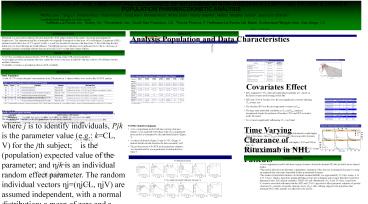July 12, 2002 Version - PowerPoint PPT Presentation
1 / 1
Title:
July 12, 2002 Version
Description:
characterization of the time-varying clearance of rituximab in non-hodgkin s lymphoma patients using a population pharmacokinetic analysis *micha levi1, *jing li2 ... – PowerPoint PPT presentation
Number of Views:80
Avg rating:3.0/5.0
Title: July 12, 2002 Version
1
CHARACTERIZATION OF THE TIME-VARYING CLEARANCE OF
RITUXIMAB IN NON-HODGKINS LYMPHOMA PATIENTS
USING A POPULATION PHARMACOKINETIC ANALYSIS
Micha Levi1, Jing Li2, Nicolas Frey3, Thian
Kheoh4, Song Ren2, Michael Woo2, Amita Joshi2,
Nancy Valente2, Nelson Shasha Jumbe2, Jean-Eric
Charoin3 contributed equally to this work
Hoffman-La Roche Inc., Nutley, NJ ,2Genentech,
Inc., South San Francisco, CA , 3Roche Pharma, F.
Hoffmann-La Roche Ltd, Basel, Switzerland 4Biogen
Idec, San Diego, CA
INTRODUCTION
RESULTS
Rituximab is a monoclonal antibody directed
against the CD20 antigen found on the surface of
normal and malignant B lymphocytes. The
elimination half-life of rituximab was originally
determined on data from 14 Non-Hodgkins Lymphoma
(NHL) patients treated with a dose of 375 mg/m2
weekly x 4, and was described to increase with
time from 3.2 days following the first infusion
to 8.6 days following the fourth infusion. The
half-life increase with time was hypothesized to
be due to a decrease of rituximab clearance
coinciding with the decrease in B-cell (CD19)
count and/or tumor burden.
Analysis Population and Data Characteristics
OBJECTIVES
- to develop a population pharmacokinetic (POP PK)
model using a large NHL patient population - to investigate possible mechanisms that may
explain the observed increase in half-life with
time such as a B-cell/tumor burden mediated
clearance - to identify covariates as potential predictors of
PK variability
METHODS
Study Population A total of 3739 serum rituximab
concentrations from 298 patients in 6 clinical
studies were used in this POP PK
analysis. Tested clinically relevant
covariates are listed in Table 2 Data
Analysis A POP PK Model was simultaneously fitted
to the pooled data from the 6 clinical studies
using the FOCE INTER method of NONMEM V. The
interindividual variability in the PK parameters
was modeled generically where j is to identify
individuals, Pjk is the parameter value (e.g.
kCL, V) for the jth subject is the
(population) expected value of the parameter and
?jk is an individual random effect parameter. The
random individual vectors ?j(?jCL, ?jV) are
assumed independent, with a normal distribution
a mean of zero and a variance ?2. The residual
variability was described by a combined additive
and proportional error model where Cij is the
jth measured observation in individual i, is
the jth model-predicted value in individual i,
and epij and eaij are proportional and additive
residual random errors, respectively, for
individual i and measurement j and are each
assumed to be independently and identically
distributed The effects of continuous
covariates and the categorical covariates were
described Where continuous covariates (centered
around their median (med(Xl)) values) were
modeled using the multiplicative power model,
thus allowing ?l to represent the P estimate for
the typical patient with median continuous
covariates. Categorical covariates were coded as
0 or 1. ?m represents the fractional change in
when Y1. A non-parametric bootstrap was
used to estimate the precision of model
parameters. A visual predictive check (VPC) was
used to assess the model performance.
Covariates Effect
- BSA explained 27.3 of the inter-individual
variability in V1 based on the final covariate
model using pooled data - SPD and CD19 at baseline were the most
significant covariates affecting CL2 at time zero
- The baseline SPD was the most important covariate
on Kdes - The large inter-individual variability in CL2 and
Kdes remained unexplained despite the inclusion
of baseline CD19 and SPD covariates in the PK
model - No covariate significantly influencing CL1 was
found
- POPPK Model Development
- A two compartment model with time-varying
clearance (Figure 2) was markedly better than of
the two-compartment linear model as determined by
the individual-fit plots (Figure 3) - Goodness-of-fit plots (Figure 4) and by VPC
(Figure 5) indicate that the model describes the
data reasonably well - The good precision of POP PK model parameter
estimates was demonstrated by a non-parametric
bootstrap listed in Table 5
Time Varying Clearance of Rituximab in NHL
Patients
- The total clearance (CLtotal) after the first
infusion of rituximab is much higher than at
later times, where CLtotal is determined by the
non-specific clearance (CL1) only - The higher specific clearance (CL2) correlated
with higher CD19 and SPD at time zero - Figure 6 illustrates the gradual decrease in
CLtotal with diminishing CD19 counts and SPD
after rituximab treatment
CONCLUSIONS
Figure 3. Representative individual-fir of the
POPPK model, comparing 2-compartments linear
model to 2-compartments with time varaying
clearance
- A two compartment model with time-varying
clearance described rituximab PK data pooled from
six clinical studies. - This model offered for the first time a
quantitative estimation of the decrease in
rituximab clearance by using an empirical first
order time-dependent decline in rituximab
clearance. - The median of individual estimates of rituximab
terminal half-life was approximately 22.4 days
(range, 6.14 to 51.9 days), which is typical for
immunoglobulin isotype IgG in humans and is
longer than that reported for humanized anti-CD20
clinical candidates, IMMU106 and ofatumumab of
12.0 and 14.3 days, respectively. - Covariates associated with tumor burden (SPD and
CD19) appeared to affect parameter estimates of
specific clearance(CL2) and rate of specific
clearance decay (Kdes), thus, offering support to
the hypothesis that rituximab PK in NHL patients
was affected by the disease.































